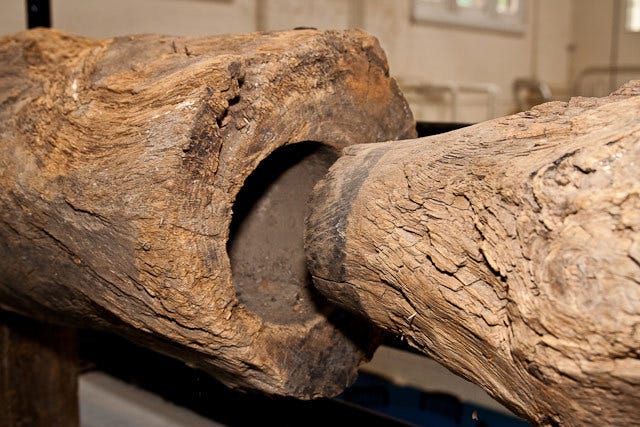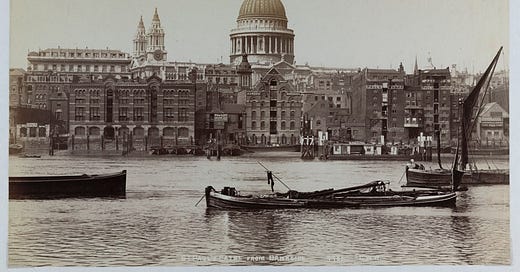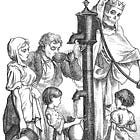Programming note: This is the second instalment in a series on London Sewage.
The summer of 1858 witnessed an unprecedented sewage crisis in London that became known infamously as the “Great Stink.”
Within the Houses of Parliament, the curtains and drapery were soaked in chloride of lime to create a barrier against the putrid odours emanating from the River Thames. According to a contemporary newspaper, The Examiner, the Chancellor of the Exchequer, Benjamin Disraeli, entered one of the committee rooms only to depart shortly afterwards “with a mass of papers in one hand, and with his pocket handkerchief applied to his nose,” repelled by the stench.
What circumstances had transpired to transform the Thames into such a health hazard?

A short history of sewage in cities
Human waste management systems have varied dramatically across place and time, but effective sewage management has been the invisible enabler of urban development throughout history, creating the conditions for population density that would otherwise be impossible due to disease and contamination.
More complex sewage management systems have been developed at least since the 3rd millennium BC. At that time, the earliest civilisations in Ancient Mesopotamia and in the Indus Valley constructed sewage channels and brick-lined sewers at sites such as Uruk, Harappa, and Mohenjo-daro.
The pinnacle of ancient sewage engineering and sanitation is perhaps the Cloaca Maxima, Rome's monumental central sewer. Initiated in around 600BC, it has functioned continuously for over 2,500 years since, surviving even the end of the Roman Empire.
From there, sewage systems evolved variously as seen in medieval street gutters or Islamic ablution-related innovations, each different approach solving the fundamental challenge of removing contaminated waste from densely-populated human habitations.
A short history of sewage in London
In any city, sewage wastewater systems need to work in combination with a system for draining rainwater as well as a system for providing fresh water
In London, water was initially piped for fresh distribution, not sanitation. The Thames and other London streams were crucial for the supply of fresh drinking water, serving as the lifeblood of the growing metropolis.
During the Roman era, inhabitants laid clay pipes to carry the waters of the Walbrook to the public baths. In the 13th century, nobleman Gilbert de Sandford granted public access to Tyburn springs, piping water from there to the City of London via the Great Conduit, a channel made of clay, sandstone, lead and elm pipes.

In 1582, Peter Morice, a Dutchman, built pumps powered by waterwheels at London Bridge to draw drinking water into the City. By 1613, merchant Hugh Middleton had constructed the "New River," an artificial waterway that brought fresh water 42 miles from Hertfordshire springs. In 1723, the first company of several, the Chelsea Water Company, was established to draw “fresh” water from the Thames for drinking and household usage, which it continued to do without filtration until the mid-19th century.
In London, in terms of wastewater management, for most of its history, the city relied on natural underground streams for the drainage of storm and rain wastewater and relied on cesspools for the removal of sewage wastewater.
Cesspools were underground pits that collected and stored sewage from specific buildings. Cesspools were emptied by “night soil men” (also known as “gong farmers”) who sold the contents to farmers outside the city for fertiliser. This system remained the primary disposal method until the 19th century, when London’s rapid growth made it unworkable.

The city’s population doubled from 1 million to 2 million between 1801 and 1851, and from there nearly tripled to 5.6 million by 1891. London’s natural underground streams were gradually reconstituted over time as brick-covered sewers with some exceptions (such as Beverly Brook and the Wandle).

These street sewers, originally designed only for rainwater, underwent a further dramatic transformation as housing density increased.
Cesspools frequently overflowed and many homes begun to connect their wastewater to the street sewers. As early as 1660, Samuel Pepys recorded that: “[Upon] going down to my cellar… I put my feet into a great heap of turds, by which I find that Mr Turner’s house of office is full and comes into my cellar.”
Indeed, after 1815, building regulations were formally modified to permit house drains to connect to public sewers. It was only in 1822, seven years after household waste was officially permitted to enter the Thames, that the London Bridge waterwheel water supply system, originally devised by Peter Morice, was discontinued.
The introduction of water closets (flush toilets, whose inventor, Thomas Crapper, provides an almost implausibly perfect example of nominative determinism) further exacerbated the situation by dramatically increasing household wastewater volume, creating serious public health risks. The last salmon to be caught be local fishermen from the river was in June 1833.1
As a result, the sewers, which emptied directly into the river, began to pollute the Thames and transform it from a relatively pristine river into an open sewer.
The Metropolitan Commission of Sewers (1849-1856)
The problem of sanitary reform, although well-established, had gone unsolved for many years.
The Bills of Sewers 1531, was the earliest major attempt to regulate London’s sewers in a systematic manner with eight local boards of commissioners. Later, in the wake of the Great Fire of London of 1666, the celebrated architect Sir Christopher Wren submitted a proposal for improved drainage, water supply, and sewerage to the Westminster Commission during the rebuilding of the City .
It was only the rapid growth of the metropolis in the 19th century and a landmark report published by Edwin Chadwick that brought sewage back as a critical topic of debate. Chadwick was a utilitarian social reformer and his report on the Sanitary Condition of the Labouring Population 1842 demonstrated the link between poverty and disease.
Subsequently, Parliament passed the Public Health Act 1848 consisting of historically significant reforms. It established a central Board of Health with unprecedented powers, enabled local authorities to levy taxes for sanitation improvements, and marked the beginning of governmental responsibility for public health infrastructure.

In 1848, catalysed by London’s second cholera epidemic, Parliament established the Metropolitan Commission of Sewers to address the mounting sanitation crisis.2
Though relatively short-lived and under-funded, the Commissions made several lasting contributions; namely:
The first comprehensive survey of London’s sewer system.
The requiring sewer connections for all new construction,
An invitation for proposal to improve London’s sewage system, which returned 137 proposed plans, from which a final preferred plan was commissioned from Frank Forster for a main drainage system with intercepting sewers was selected in 1850.
By 1855, the Commission, already in its sixth iteration, finding itself hampered by internal disputes, a lack of funding ,and an inability to make compulsory land purchases, was dissolved by Parliament. Following the 1854 Broad Street cholera outbreak, which renewed the sense of urgency for sanitary reform, Parliament dissolved the Commission and replaced it with a new Metropolitan Board Works by the Metropolis Management Act 1855.
The Metropolitan Board of Works (1856-1889)
The Great Stink of 1858 marked a key turning point in London’s relationship with sewage. In June of that year, a heat-wave descended on the city, causing untreated wastewater to ferment in the city’s rudimentary drainage system.
On account of the Thames being a tidal river, an ever-increasing volume of human, animal, and industrial waste was borne repeatedly up and down the stream. As drought conditions lowered the Thames’ water levels, exposed raw sewage on the riverbanks released noxious gases that intensified the pre-existing stench.
The crisis generated widespread public outcry. The author Charles Dickens, writing to a friend in July 1858, noted that: “The Thames in London is most horrible... The offensive smells [are] of a most head-and-stomach-distending nature.”
The effects of the heat-wave penetrated even the highest echelons of society. Queen Victoria and Prince Albert were forced to abandon a pleasure cruise on the river, while Parliament found itself unable to function and considered relocating from Westminster to Henley-upon-Thames.
The Times of London captured the scene in a front-page editorial:
“Parliament was all but compelled to legislate upon the great London nuisance by the force of sheer stench. The intense heat had driven our legislators from those portions of their buildings which overlook the river. A few members… ventured into the library, but they were instantaneously driven to retreat, each man with a handkerchief to his nose.
We are heartily glad of it.”
The severity of the unsanitary conditions of 1858 focussed legislative minds once more and, in July, Parliament passed a further Metropolis Management Amendment Act 1858 to extend the powers of the Board of Works.
The Amendment granted the Metropolitan Board of Works extraordinary new powers, including the authority to raise bonds to finance the massive infrastructure project and to compulsorily purchase land for construction.
Most crucially, the Act contained unambiguous language that left no room for further delays or half-measures:
“The Metropolitan Board shall cause to be commenced as soon as may be after the passing of the Act and to be carried on and completed with all convenient speed according to such plan as to them may seem proper the necessary Sewers and Works for the Improvement of the Main Drainage of the Metropolis, and for preventing as dar as may be practicable, the sewage of the Metropolis from passing into the River Thames within the Metropolis.”
Metropolis Management Amendment Act 1858
This legislative mandate effectively authorised the creation of what would become the most ambitious civil engineering project of the Victorian era.
Fortunately, the man who would transform this mandate into reality had already been appointed to the Board in 1856. That man was Joseph Bazalgette, the Chief Engineer of the Metropolitan Board of Works.

Bibliography
Stephen Halliday (1997) Thesis: Sir Jospeh Bazalgette and the Main Drainage of London.
Stephen Halliday (2023). The Great Stink: Sir Joseph Bazalgette and the Cleansing of the Victorian Metropolis.
R. Fitter, London’s Natural History (1945), p.82.
The commission was formed by the Metropolitan Commission of Sewers Act 1848 (11 & 12 Vict. c. 112), partly in response to public health concerns following serious outbreaks of cholera. The commission's mandate was renewed and amended with supplementary acts:
Metropolitan Sewers Act 1851 (14 & 15 Vict. c. 75)
Metropolitan Sewers Act 1852 (15 & 16 Vict. c. 64)
Metropolitan Sewers Act 1853 (16 & 17 Vict. c. 125)
Metropolitan Sewers Act 1854 (17 & 18 Vict. c. 111)
Metropolitan Sewers Act 1855 (18 & 19 Vict. c. 30)
Commissioners included Sir Edwin Chadwick, Robert Stephenson and Thomas Field Gibson. The new body combined eight local boards of commissioners that had been established by the 1531 Bill.





